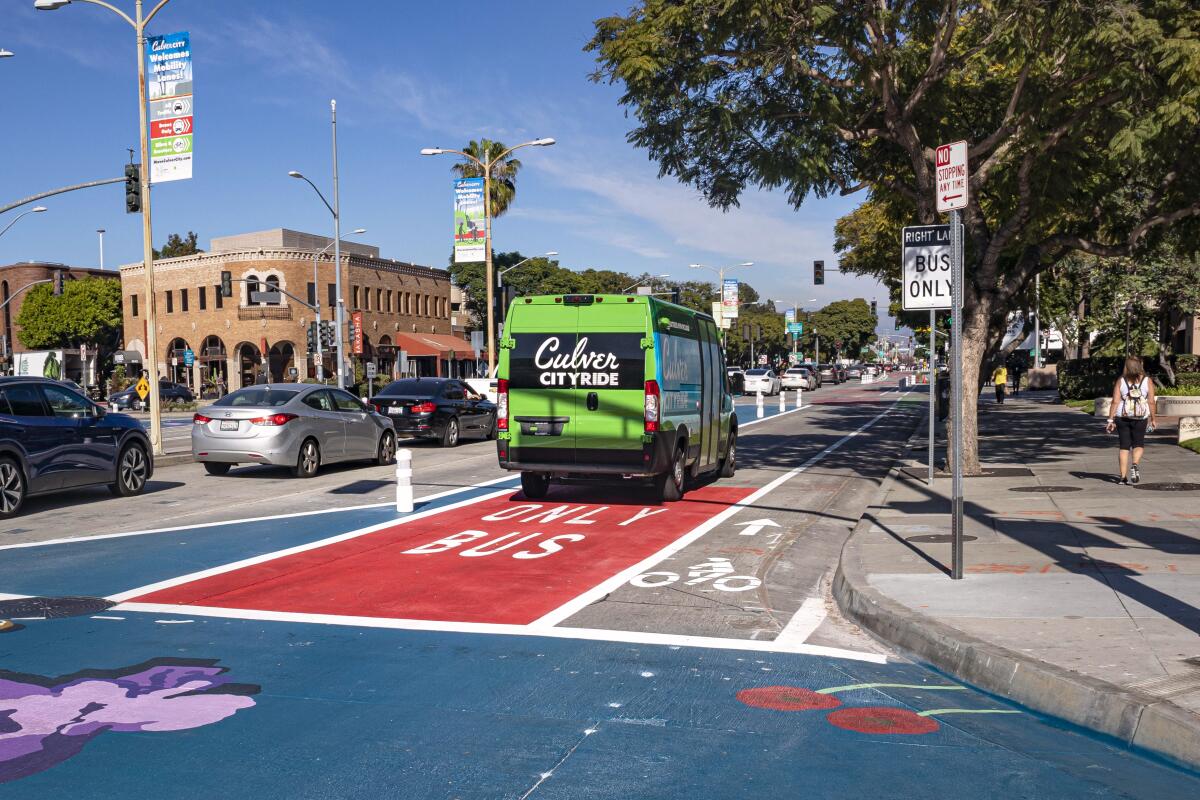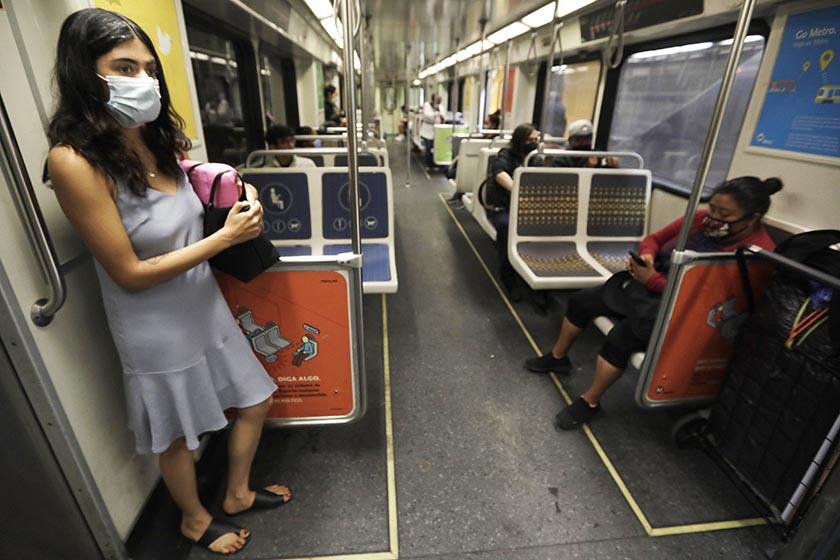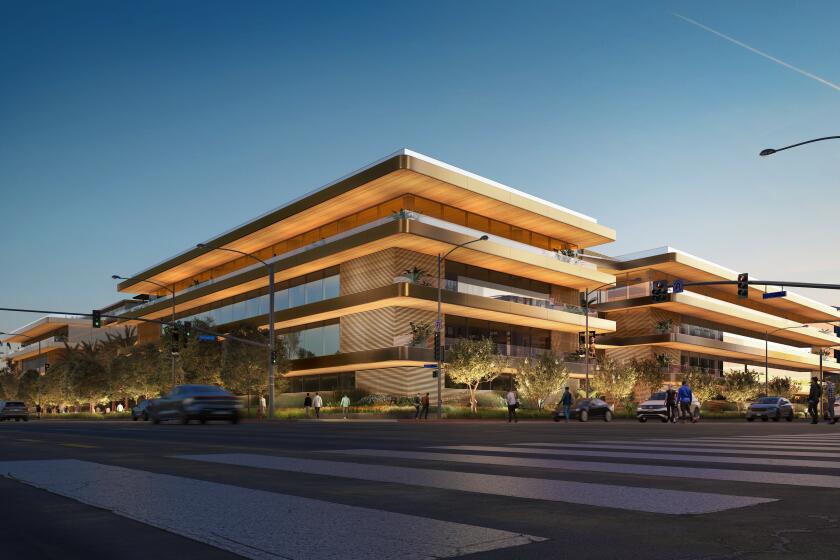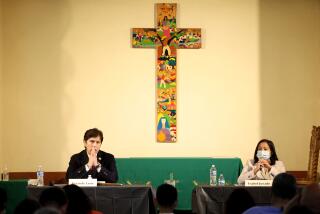Opinion: Cars don’t have to rule Culver City, or the future of L.A. transit

- Share via
On April 24, the Culver City Council is expected to vote on the controversial mobility project Move Culver City, a pilot of protected bus and bike lanes put in place during the pandemic along a 1.3-mile downtown corridor.
Culver City is a small town, and 1.3 miles of transportation infrastructure may seem inconsequential. However, if the city votes to take down the project — an outcome that seems likely given a new, more conservative majority seeking to weaken the previous council’s progressive policies — it will be a devastating setback, not just for those of us who use the lanes but also for how Angelenos see the future of transportation in our region.
As a Culver City resident, mom, cyclist and enthusiastic supporter of public transit in my private and professional life, my position on the mobility project is not detached. I’m one of the many people enjoying the benefits highlighted in Move Culver City’s mid-pilot report (literally — that’s me on the cover, the mom on the cargo bike with my daughter, her friend and their stuffed animal friend Marley).
COVID, remote work and crime have mass transit in crisis. Los Angeles’ rail system can thrive again with transit-oriented development and housing.
Drivers complain that the bus and bike lanes slow down traffic on the street. But the lanes don’t do so by much: According to the report, during peak afternoon traffic, travel time in a car has increased by a maximum of two minutes compared with a 2019 baseline. Meanwhile, overall traffic on the corridor has diversified and increased, with marked gains in bus ridership, cycling and pedestrian activity. Also important, the bus and bike lanes protect bikers, pedestrians and even other drivers from traffic violence that occurs with increased speeds.
I regularly ride through the corridor on my bike — to downtown Culver City, the E line (Expo) station, the grocery store, my daughter’s ballet class — smiling smugly as I whiz safely past cars. My husband, even more principled (and maybe even more smug), often makes a point of taking the bus to these destinations rather than using our car. But we also have the privilege of electing to do so. Many people riding the bus in L.A. County are not doing so on principle or because it’s fun, but because it’s the most viable option for them. A bus lane makes their lives better too.
Even I can admit that the implementation of the Move Culver project has not been flawless. The signaling system and striping has at times been confusing, though city staff has been responsive to complaints from residents. And the project is wasting money on a minibus circulator service, destined for the E line stop, that too often sits empty because it doesn’t go far and no one seems to understand what it is. Those resources would be better put toward making service more frequent and expanding routes for Culver’s existing bus lines.
A common argument coming from some council members and opponents of the project is that because bus service is currently inadequate, prioritizing buses over cars with a dedicated lane does not maximize use of the road. They argue the infrastructure lacks support and utilization because of our car-centric culture and low ridership.
Apple will break ground on a new office this year on the Culver City-Los Angeles border that will house up to 2,400 employees, raising concern among some residents that it will increase their rent.
Those are not reasons to remove bus and bike infrastructure — those are reasons to double down. Council members are the decision makers. If bus service is not up to par to maximize the protected lane, then it is on them to make it better. If the project lacks support, then they need to invest in the service frequency, reliability and connectivity to strengthen the ridership and thus the buy-in.
Well-supported bus and bike infrastructure is the cheapest and fastest approach to making transit more accessible, equitable, environmentally sustainable and convenient, which will make our urban spaces more livable as a result. Extensive research and real-life examples show that with solutions such as dedicated bus lanes, more frequent and reliable service, and connecting the first and last miles of routes, people will opt for public transit. It’s as simple as the “Field of Dreams” philosophy: If you build it, they will come. Look at the massive bus systems in Bogota or London or, here in the U.S., successful service overhauls in Chicago and Seattle.
We are facing climate and traffic violence crises that are killing people, and that are exacerbated by housing costs that push workers farther and farther away from their places of work. These crises are overwhelming — but they are also urgent and require political courage. It doesn’t make sense to stymie the approaches that help us meet the moment, all in deference to the “car country” mentality that got us here in the first place.
Sure, a 1.3-mile corridor is just a 1.3-mile corridor. But it could be so much more.
Yotala Oszkay Febres-Cordero is an economic and political sociologist, American Council of Learned Societies Leading Edge Fellow and researcher with the Alliance for Community Transit-Los Angeles.
More to Read
A cure for the common opinion
Get thought-provoking perspectives with our weekly newsletter.
You may occasionally receive promotional content from the Los Angeles Times.












